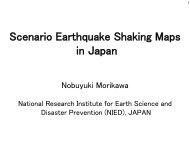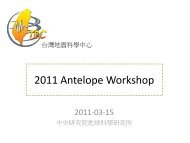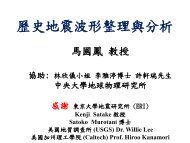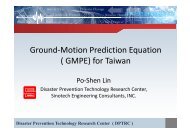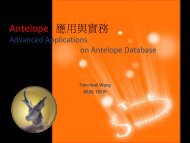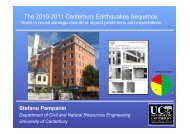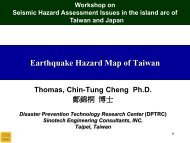Ching et al. [2011]
Ching et al. [2011]
Ching et al. [2011]
- No tags were found...
You also want an ePaper? Increase the reach of your titles
YUMPU automatically turns print PDFs into web optimized ePapers that Google loves.
Taiwan geod<strong>et</strong>ic strain rate modelGroup members:Ya-Ju Hsu (IES)Jian-Cheng Lee (IES)Jyr-<strong>Ching</strong> Hu (NTU)Wen-Jeng Huang (NCU)Wu-Lung Chang (NCU)Kuo-En <strong>Ching</strong> (NCKU)Ruey-Juin Rau (NCKU)Ruey-Juin RauDepartment of Earth Sciences, Nation<strong>al</strong> Cheng Kung University, Tainan, Taiwan1
Outlines:1. Why strain rate matters?2. What is the current status of Taiwanstrain rate model?3. What are the short-term go<strong>al</strong>s?4. What are the long-term considerations?2
Seismic Hazard An<strong>al</strong>ysis1. Earthquake rupture forecastGives the probability of <strong>al</strong>l possible major earthquakeruptures throughout the region and over a specified time span2. Earthquake shaking modelFor a given earthquake rupture, this gives the probability thatan intensity-measure type will exceed some level of concern3
Seismic Hazard An<strong>al</strong>ysis1. Earthquake rupture forecastGives the probability of <strong>al</strong>l possible major earthquakeruptures throughout the region and over a specified time span2. Earthquake shaking modelFor a given earthquake rupture, this gives the probability thatan intensity-measure type will exceed some level of concern4
System-level Science6
Why strain rate matters in earthquakeforecasting?7
Strain rate1. Reflects elastic stress buildup.2. Effects rheology.3. Help for earthquake forecast?8
Interseismic model for avertic<strong>al</strong> strike-slip faultStrain rate1. Reflects elastic stress buildup.2. Effects rheology.3. Help for earthquake forecast?VelocityStrain rateMoment rateSavage and Burford, 1973;Smith-Konter <strong>et</strong> <strong>al</strong>., <strong>2011</strong>9
Interseismic model for avertic<strong>al</strong> strike-slip faultStrain rate1. Reflects elastic stress buildup.2. Effects rheology.3. Help for earthquake forecast?VelocityStrain rate= velocity / locking depthMoment rate= velocity * locking depthSavage and Burford, 1973;Smith-Konter <strong>et</strong> <strong>al</strong>., <strong>2011</strong>10
Geod<strong>et</strong>ic measurements estimateboth the strain accumulation rate andthe moment accumulation rate11
Deformation modelsEach deformation model gives slip-rate estimates atvarious locations on a given fault model, plusdeformation rates off the explicitly modeled faultsThe Uniform C<strong>al</strong>ifornia Earthquake RuptureForecast, Version 3 (UCERF3) Project Plan(<strong>2011</strong>) 12
Deformation modelsEach deformation model gives slip-rate estimates atvarious locations on a given fault model, plusdeformation rates off the explicitly modeled faultsfault slip rates and off-fault strain rates are estimatedfrom inversions of GPS-derived velocities andgeologic slip rates with kinematic modelsThe Uniform C<strong>al</strong>ifornia Earthquake RuptureForecast, Version 3 (UCERF3) Project Plan(<strong>2011</strong>)13
Problems in strain rate models1. Null space in strain rate maps2. Kinematic models for fault slip rate14
Comparison of strain rate map in S. C<strong>al</strong>ifornia15
16Johnson, 2010
Johnson, 201018
What is the current status of Taiwanstrain rate model?19
台 灣 地 區 GPS 水 平 速 度 場1995-2005 2002-201020
Strain rate field of Taiwan21
2001-<strong>2011</strong>/5 GPS 連 續 站 速 度 場 分 析Campaign22
2001-<strong>2011</strong>/5 平 面 應 變 率 分 布23
Taiwan Velocity FieldGPS Horizont<strong>al</strong> VelocitiesShort-term Vertic<strong>al</strong> VelocitiesLong-term Vertic<strong>al</strong> Velocities24
Tectonic Block and Fault Configurations1. Active faults (CGS and CPC)2. Seismicity (CWB)3. Velocity Field<strong>Ching</strong> <strong>et</strong> <strong>al</strong>. [<strong>2011</strong>]25
Locations of Euler Poles, Block Motions, andInterseismic Slip Rates on the FaultsLong-term Slip Rates on the Faults<strong>Ching</strong> <strong>et</strong> <strong>al</strong>. [<strong>2011</strong>]26
Modern Tectonic Model of Taiwan<strong>Ching</strong> <strong>et</strong> <strong>al</strong>. [<strong>2011</strong>]27
Distribution of Slip Rate DeficitDistribution of the destructive earthquakes inTaiwan since 19002.91 × 10 17 N-m/yrRecurrence Interv<strong>al</strong>: ~970 yrs<strong>Ching</strong> <strong>et</strong> <strong>al</strong>. [<strong>2011</strong>]28
Distribution of Slip Rate DeficitDistribution of the destructive earthquakes inTaiwan since 19006.70 × 10 17 N-m/yrRecurrence Interv<strong>al</strong>: ~594 yrs<strong>Ching</strong> <strong>et</strong> <strong>al</strong>. [<strong>2011</strong>]29
Problems for the Taiwan strain ratemodel and the short-term go<strong>al</strong>s30
Problems for the Taiwan strain ratemodel and the short-term go<strong>al</strong>s1. Data consistency problem2. Strain rate model c<strong>al</strong>culations3. Kinematic models4. Taiwan strain rate model - version 131
Long-term go<strong>al</strong>s1. New observations2. Modeling of earthquake cycle deformation3. Refine block models4. Improve Taiwan strain rate model32
Major earthquake sourcesin and around Taiwan(Shyu <strong>et</strong> <strong>al</strong>., 2005) 34


![Ching et al. [2011]](https://img.yumpu.com/47779892/1/500x640/ching-et-al-2011.jpg)
